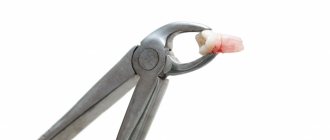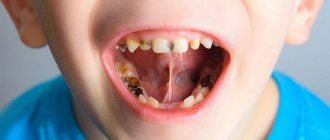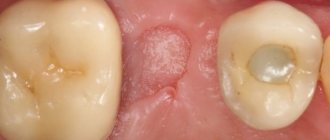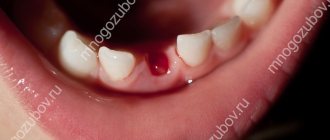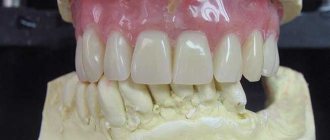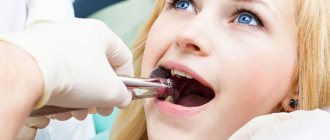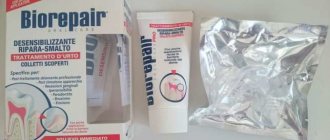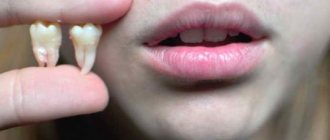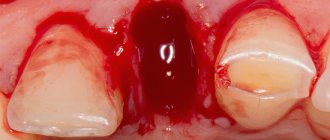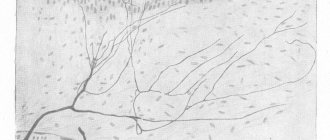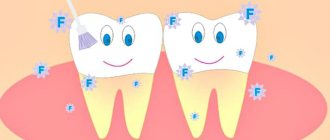Why are baby teeth important?
At about three years of age, the roots of a child's baby teeth begin to dissolve, causing the baby teeth to become loose and then fall out. Thus, the milk bite changes to a permanent one. This is a natural process of changing teeth, and in most cases it proceeds without complications, without requiring medical intervention. The role of baby teeth in it is very important - they help permanent teeth to properly erupt and fit in the mouth. In addition, they stimulate the growth and development of the jaw bone. If you notice a crooked baby tooth in a child, be sure to show it to an orthodontist.
How to extract a child’s baby tooth (at home) –
To begin with, you should wash your hands well, and the child should either rinse his mouth with an antiseptic, or you can spray with an antiseptic spray (for example, Miramistin). If you want to reduce your child’s pain as much as possible, you can purchase the anesthetic Lidocaine, which is sold at any pharmacy. Liberally soak a small cotton ball or gauze swab with the contents of the anesthetic ampoule and apply it to the gum around the tooth (both external and internal). It is best to buy a package of sterile gauze swabs for this, or make them yourself - from a regular sterile bandage.
Hold the anesthetic swab with your fingers for 1-2 minutes. After this, you will need dental floss (such as Oral-b). This is a very strong and at the same time sufficiently thin thread, which is usually used for completely different purposes - to clean the dental spaces from food debris. Using regular sewing thread is much less effective, and they often break, which leads to more and more attempts, i.e. prolongation of this not very pleasant procedure for the child. The removal of a baby tooth in a child is shown in detail in the following video.
How to pull out a baby tooth for a child (video 1) –
After removal, there may be some bleeding. You can spray the wound with an antiseptic and apply a sterile gauze pad over it (for 5-10 minutes), or apply a sterile gauze pad soaked in antiseptic to the wound. And one more very important point - do not torture the child and try to remove teeth that are not very mobile. This risks the fact that root fragments may remain in the wound, and in this case purulent inflammation will certainly develop (24stoma.ru). In addition, you should not remove even mobile baby teeth, in the projection of which there is a purulent abscess in the form of a lump on the gum (this should only be done by a dentist).
After removal, be sure to maintain oral hygiene and monitor whether gum inflammation has appeared in the area of the extracted tooth. Also keep in mind that it will be easiest to remove a baby tooth at home if it is a front tooth. These are single-rooted teeth, and if the crown is sufficiently mobile, the tooth can be pulled out quite easily with floss (dental floss) without damaging the soft tissues of the cheeks and lips. With teeth from the lateral areas of the dentition, things are more complicated, because this means less convenient access. In addition, temporary molars (4-5 teeth) have two roots, and therefore it will be more difficult to remove such teeth (plus there is a higher risk that a root fragment will remain in the wound).
What are the risks of early removal of baby teeth?
Premature loss of a baby tooth is considered to be the case when more than a year remains before the appearance of a new one. If a child loses a tooth ahead of schedule, his remaining “brothers” strive to take the free space. As a result, permanent teeth erupt chaotically, which can subsequently lead to the development of malocclusion in children, which will require long-term and complex orthodontic treatment. Another negative consequence of early removal of baby teeth is a decrease in the rate of jaw development, which also leads to deformation of the dentition - the teeth do not have enough space and they overlap one another. Therefore, experienced dentists perform this procedure extremely rarely and only for special indications.
Removal of a milk tooth: price for the service in Moscow
The price of extraction depends on the type of temporary tooth, the degree of its mobility, the use of anesthesia, etc. When searching for the phrase “baby tooth extraction, price, Moscow,” you can find options starting from 900 rubles. However, this applies to the simplest situations (for example, a single-rooted and mobile tooth). If, according to indications, a more complex (for example, early) removal of a baby tooth is required, the price for it in Moscow clinics is slightly higher.
When typing the phrase “baby tooth extraction, price, Moscow” into a search engine, you should also pay attention to the qualifications of the doctors. It also often affects the cost of the service. But this is justified, since extraction in children requires great professionalism, so it is better not only not to carry it out at home, but also to choose a good doctor.
The Novodent clinic also performs milk tooth extraction. The price for the service is indicated in the “Cost” section.
What to do if you had to remove several baby teeth?
If premature removal of a baby tooth is inevitable in a child, then dentures are necessary. Most often these are removable plates with an artificial tooth. For large losses, doctors install crowns made of plastic or metal. This is necessary in order to prevent displacement of the dentition. And then new teeth will grow in the right place.
The role of primary teeth in the development of the maxillofacial apparatus
Baby teeth, the so-called temporary teeth, help babies learn to chew solid food, while developing not only the jaws, but also the maxillofacial muscles. Starting from the age of six months, small teeth begin to emerge in infants. This process is accompanied by pain, swelling of the gums and fever.
With the appearance of each new element, the milk dentition is formed, laying the preconditions for the appearance of permanent teeth. At this time, the bite is formed, the muscles develop, and the jaws are formed. The baby learns to pronounce the first words, gradually developing speech skills.
What are the indications for the removal of baby teeth?
There are situations when it is impossible to do without tooth extraction. For this purpose, there are relative and absolute indications for the removal of baby teeth. Absolute indications include the following cases:
- The baby tooth is so damaged by caries that it cannot be restored;
- The presence of a tooth that for some reason cannot be treated;
- The permanent tooth is already visible, and the milk tooth is not even loose;
- Formation of a cyst on the roots of a tooth;
- Fistula on the gum of a child;
- Severe periodontitis or pulpitis, especially in cases where inflammation threatens the death of the permanent tooth germ;
- Root resorption occurs with a delay, which prevents the eruption of a permanent tooth;
In addition to absolute indications for the removal of a baby tooth, there are also relative ones. The most common relative indication for removal: baby teeth are loose, but do not fall out, or a loose tooth causes discomfort, provoking the onset of an inflammatory process of the gums, which makes it painful for the child to eat. In these cases, you should not wait until the tooth falls out on its own. It's better to consult a specialist. Relative indications also include tooth fractures, chronic periodontitis or pulpitis.
Adults also have milk teeth. If there are rudiments of a permanent tooth, then you should think about removing the temporary tooth and “pulling out” the permanent one.
Tooth extraction in children
For a child, tooth extraction can be the most terrible event in his life. Only parents can show that such a procedure is painless. Be calm and confident. Then the child will accept the situation like a hero.
Every child faces this operation. It may be needed at any age of a growing baby.
Both baby and permanent teeth are removed. Dentists try to get by with treatment, because tooth extraction in children can cause serious consequences. For example, the appearance of an incorrect bite.
Dairy products must be carefully looked after. They help in speech development, jaw formation and the chewing process. Therefore, you should preserve them for as long as possible in order to avoid many problems with the development of the dental cavity in the future. The need to remove primary and molar teeth in children is dictated by the following processes:
- caries, phlegmon, periodontitis;
- the process of eruption of molars is disrupted;
- if the tooth should already fall out, and the roots have not resolved, giving the molars the opportunity to grow;
- tooth fracture or injury;
- loose teeth.
Baby teeth appear at about 6 months. The first examination will show the possible presence of problems and the progress of the teething process. At 2 years old, you can introduce your child to the doctor, talk about the importance of hygiene and developing a positive attitude towards the dentist. Around 6 years of age, baby teeth begin to loosen and fall out.
How to prepare children for tooth extraction?
In order for the child to be psychologically prepared for the operation and not be afraid of the doctor, he must be prepared in advance. The following few tips will help support your baby:
Do not talk about the operation in a negative way, or scare about the upcoming pain. Replace the words “scary”, “painful”, “unbearable” and other similar words, for example, with “easy”. The concept of anesthesia is a pleasant dream. A young patient should not hear adults discussing the operation and consequences. Distract the baby from observing the preparation for removal (conversations, cartoons or a song). The hospital office itself can be intimidating. Shiny cold instruments will provoke panic. If the parents are calm, then the child will feel comfortable.
How are teeth removed?
Tooth extraction in children requires a lot of attention. The anatomy of a child's jaw is still developing. Careless movements by the doctor can lead to damage to permanent teeth. The operation lasts a short time. Using special forceps, the dentist carefully twists the tooth out of the cavity without damaging the molars.
In any case, pain relief is necessary. Otherwise, you can harm your psyche. It is administered using general anesthesia, injection or topical anesthesia (sweet-flavored gels). Both one method and a complex are used.
Baby teeth often fall out on their own. But if you had to contact a specialist, then don’t panic. Parental peace of mind will pass on to the baby, and the operation will be successful.
You can make an appointment here.
What is the technique for removing baby teeth?
The procedure for removing baby teeth requires great care and skill, because it is characterized by a number of features determined by the structure of children's teeth. They have thin alveolar walls, thinner and at the same time longer roots than permanent teeth. Anesthesia is performed in cases of serious inflammation, such as pulpitis in a child or periodontitis. If you need to remove an already loose tooth, then there is no need for pain relief. Children's dentistry in Moscow offers the cost of removing one baby tooth for about 1,000 rubles. In public clinics the procedure is carried out free of charge.
When a baby tooth cannot be saved
If a carious infection has destroyed the hard tissues of the tooth and entered the neurovascular bundle, the pulp dies, and the infection safely exits into the tissues that surround the root. In this case, the disease threatens the integrity of the primordia of permanent teeth, which are located directly above the milk roots.
Despite the fact that the tooth is severely damaged, the baby may not feel pain. This means that the inflammatory process is in a state of chronic inflammation, and pain occurs during exacerbation. When only one root remains of a tooth, the neurovascular canal is wide open.
Even during an exacerbation of chronic inflammation, when a purulent process occurs, the pus flows through the open channel and does not accumulate, so the child does not experience pain. This does not mean that such a tooth can be in the mouth. In the case of complicated caries, even in the absence of pronounced discomfort, it still needs to be removed.
It is necessary to remove a baby tooth in the following situations:
- A new tooth has erupted, but the old one has not yet fallen out;
- Complex, irreversible form of caries;
- Purulent process, cyst or fistula in the gum;
- Injuries, chips and cracks in the tooth.
The current state of health of baby teeth will certainly affect the permanent permanent teeth. Early caries prevents the normal formation of a molar and can even lead to its death. In such situations, the pediatric dentist is faced with a choice - remove or save. The priority is always to preserve the permanent tooth, so the baby tooth has to be removed.
How to remove a tooth without damaging the child’s psyche?
How to extract a baby tooth from a struggling and crying baby is a very pressing problem. Much depends on the professionalism of the doctor and the attitude of the parents. A good specialist will remove the tooth quickly and painlessly. The task of parents is not to be afraid themselves and not to groom their child with oohs and aahs. The child, seeing your fuss, will instantly decide that something terrible is about to happen. Try to give him examples of other, more flexible children, or play on the desire to be bolder than the rest of his peers. And, of course, your presence in the dental office with your child is simply necessary.
Baby teeth play an important role in the formation of permanent occlusion; the health of molars depends on them. Therefore, removing them prematurely can only be done as a last resort. Only parents are able to protect their child from such troubles by regularly attending preventive examinations and monitoring the child’s compliance with the rules of oral hygiene.
Contraindications
There are no absolute contraindications to tooth extraction. This is due to the fact that diseases and conditions for which this operation is necessary are fraught with very serious complications.
Therefore, the doctor, weighing the risks and benefits of surgical intervention, always makes a choice in favor of tooth extraction in order to stop the pathological process and prevent possible and extremely negative consequences.
But if the situation is not an emergency (for example, with phlegmon and an extremely high risk of systemic complications), the operation can be postponed to a later date.
This decision is made under the following circumstances:
- the child is in the recovery period after an illness or surgery;
- the child has an elevated body temperature or other symptoms of an acute infectious disease;
- high predicted complexity of tooth extraction, severely damaged jaw tissue, risks of complications during surgery or in the postoperative period - in this case, the child is sent to the department of maxillofacial surgery.
In each individual case, the decision on the advisability of immediate tooth extraction is made by the attending physician based on examination data and other examination methods.
Removal of front milk teeth: consequences
Since the loss of anterior primary teeth is a common phenomenon, the absence of primary elements of the anterior group is not a cause for concern in young children. However, in older children, the absence of the same teeth can cause a lot of negative emotions associated with an unattractive appearance.
The fact is that children are cruel by nature, and when they see a child with his front incisors removed, they will begin to tease and ridicule, which will inevitably cause psychological complexes (detachment, isolation, or, conversely, uncontrolled aggression).
In addition to the psychological aspect, removal of the front primary incisors will affect the development of speech skills. The child will not be able to pronounce sounds and words correctly, which will subsequently become a reason to contact a speech therapist.
